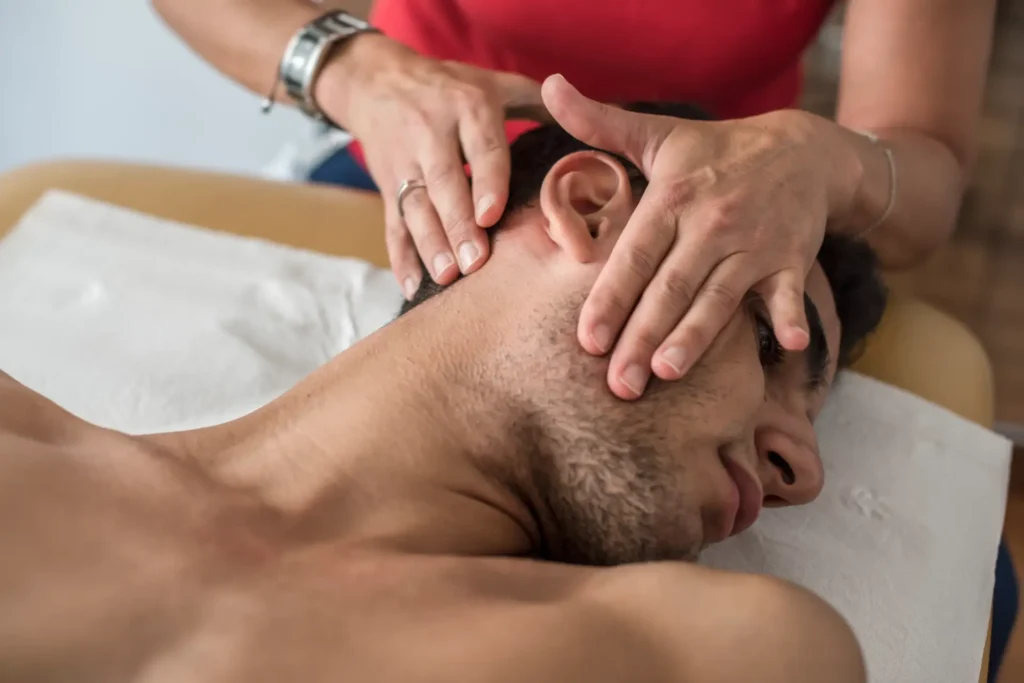Struggling with sleep? Chiropractic care, along with better sleep habits and the right pillow, might be the solution you need for a more restful night
Sleep is essential for good health, but many people face challenges due to stress, pain, and poor sleep habits. Chiropractic treatments can help improve sleep quality by addressing these issues.
Why Sleep Matters
Sleep is a fundamental need that is critical to physical and mental health. During sleep, the body goes through different cycles that help restore energy and allow the brain to process information. The two primary types of sleep—REM (Rapid Eye Movement) and non-REM—each serve important functions. REM sleep is where dreaming typically occurs, while non-REM sleep involves deeper, restorative stages.
How Much Sleep Is Necessary?
The amount of sleep required can differ based on age and personal factors. Generally, adults should aim for between 7 and 9 hours of rest each night, which is ideal. However, many people don’t manage to get enough rest. Around a third of adults report getting less sleep than recommended, and many high school students also fail to get adequate sleep on school nights. Consistency in sleep patterns—going to bed and waking up at the same time every day—is also beneficial for better quality rest.
What Happens When You Don’t Get Enough Sleep?
If you don’t get enough sleep, it can show up quickly. You might feel tired, irritable, and have trouble focusing. Your mood and ability to make decisions can suffer, too. Over time, an ongoing lack of sleep can lead to mental health issues, including anxiety and depression. These conditions can also make sleep problems worse, creating a cycle that’s hard to break.
The Link Between Sleep and Physical Health
Not getting enough sleep can increase the chances of developing serious health problems, such as heart disease, diabetes, and obesity. Ongoing sleep issues can also be a warning sign for more serious conditions like heart failure, osteoarthritis, or Parkinson’s disease.
Can Chiropractors Help to Optimize Sleep?
Chiropractic care can help improve sleep, especially for those dealing with pain that makes it hard to rest. For many, pain in the neck or back disrupts sleep, and poor sleep can make the pain worse. Treating both issues together is key to feeling better
Stress Reduction
Stress often interferes with sleep. Surveys show that a significant portion of people struggle with sleep due to stress. For example, 43% of American adults reported lying awake at night in the past month because of stress. Such stress-related insomnia can manifest as trouble falling asleep, frequent awakenings, or poor sleep quality.
While research is still emerging, some studies indicate that chiropractic treatments can produce changes in the body associated with stress reduction. For example, a brain scan study showed that after spinal manipulation, participants had less muscle tension and a significant drop in salivary amylase, which is a substance that helps measure how active the stress response system is in the body. This system is responsible for the “fight-or-flight” reaction when we’re stressed. This suggests that spinal adjustments may help the body relax by reducing stress.
How Spinal Adjustments Can Support Nervous System Health and Improve Sleep
Chiropractic care, particularly spinal adjustments, can help the nervous system function better by calming the stress response. This can make it easier for the body to relax, support the sleep-wake cycle, and improve sleep quality. Regular adjustments can also help reduce symptoms of anxiety and insomnia, leading to better sleep.
Chiropractic Care and Its Impact on Sleep Quality
Chronic pain, particularly in the neck or back, can make it difficult to sleep and can even make the pain worse. Chiropractic care may help by reducing muscle tension, relieving stress, and promoting relaxation, which can help improve sleep quality for people with chronic pain.
How Chiropractic Adjustments Help Relax the Body
Chiropractic adjustments aim to reduce pain and relieve muscle tension. This relaxation helps the body unwind, making it easier to sleep and improving overall well-being. By addressing the underlying causes of pain, chiropractic care can help break the cycle of pain and poor sleep.
Potential Benefits for Sleep Quality
Chiropractic care reduces pain and promotes relaxation, creating an environment conducive to better sleep. With pain management and reduced muscle tension, individuals may experience fewer interruptions during the night, improved sleep onset, and better overall sleep quality. This improvement in sleep quality can significantly enhance a person’s ability to recover physically and emotionally, benefiting their daily functioning and well-being.
Tips for Optimizing Sleep at Home
Better sleep quality is key to maintaining overall health and well-being. Below are practical tips to help optimize your sleep at home.
- Establish a Consistent Bedtime Routine: Set a routine before bed, such as dimming the lights and avoiding screens. Writing down troubling thoughts can help you fall asleep faster.
- Maintain a Consistent Sleep Routine: Going to bed and waking up at the same time every day helps regulate your body’s internal clock and promotes better sleep.
- Limit Caffeine and Alcohol Before Bed: Avoid caffeine after 2 p.m. and alcohol within three hours of bedtime, as both can disrupt sleep
- Take Short Naps: Limit naps to 20 minutes to avoid interfering with nighttime sleep.
- Be Mindful of Screen Time: Reducing screen time before bed, especially for children and adolescents, helps improve sleep quality by minimizing light exposure.
- Use Behavioral Strategies to Counteract Negative Effects: Consider using blue light filters or limiting screen time before bed to reduce its impact on sleep.
Does What I Use as a Pillow Really Matter?

The pillow you use can make a big difference in how well you sleep. A pillow that supports proper spinal alignment, like the Pillowise custom-fit pillow, can help reduce neck pain and improve sleep quality. A supportive pillow helps keep your posture in check while you sleep, making your rest more comfortable.
Ready for a better night’s sleep?
At Prestige Health and Wellness in NYC, we specialize in chiropractic care and customized solutions like the Pillowise pillow to help you sleep better. If you’re struggling with pain, stress, or poor sleep, our expert chiropractors can help. Book your appointment now and take control of your sleep.
Visit us at one of our convenient locations across NYC: Financial District, Hudson Yards, Chelsea, or Nomad. Call (917) 694-1565 or schedule a consultation today to optimize your sleep!
Sources
American Psychiatric Association. (n.d.). What are sleep disorders? https://www.psychiatry.org/patients-families/sleep-disorders/what-are-sleep-disorders
American Psychological Association. (2004, July 1). Tips for sleep success. Monitor on Psychology, 35(7). https://www.apa.org/monitor/julaug04/tips
Hartstein, L. E., et al. (2024). The impact of screen use on sleep health across the lifespan: A National Sleep Foundation consensus statement. Sleep Health: Journal of the National Sleep Foundation, 10(4), 373–384.
Inami, A., Ogura, T., Watanuki, S., Masud, M. M., Shibuya, K., Miyake, M., Matsuda, R., Hiraoka, K., Itoh, M., Fuhr, A. W., Yanai, K., & Tashiro, M. (2017). Glucose metabolic changes in the brain and muscles of patients with nonspecific neck pain treated by spinal manipulation therapy: A [18F]FDG PET study. Evidence-Based Complementary and Alternative Medicine, 2017, 4345703. https://doi.org/10.1155/2017/4345703
Kingston, J., Raggio, C., Spencer, K., Stalaker, K., & Tuchin, P. J. (2010). A review of the literature on chiropractic and insomnia. Journal of Chiropractic Medicine, 9(3), 121–126. https://doi.org/10.1016/j.jcm.2010.03.003
Van Looveren, E., Bilterys, T., Munneke, W., Cagnie, B., Ickmans, K., Mairesse, O., Malfliet, A., De Baets, L., Nijs, J., Goubert, D., Danneels, L., Moens, M., & Meeus, M. (2021). The association between sleep and chronic spinal pain: A systematic review from the last decade. Journal of Clinical Medicine, 10(17), 3836. https://doi.org/10.3390/jcm10173836



